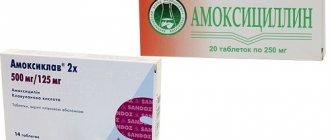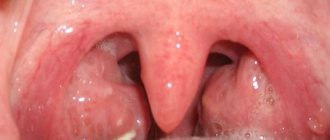Features of sore throat
Angina is characterized by an acute onset, causing a sharp increase in body temperature and a general deterioration in well-being. Hyperthermia in children can reach up to 41 degrees, in adults – up to 39⁰C.
Other characteristic signs of a developing disease are:
- The appearance of sudden fever, chills.
- Pain and redness in the throat (simultaneously with an increase in temperature or the next day).
- Difficulty swallowing, discomfort during speech.
- Plaque formation in the tonsil area.
- Swelling of the lymph nodes.
Acute bacterial tonsillitis tends to occur without a cough or runny nose, while the viral form of the disease is accompanied by rhinitis, coughing, hoarseness, and conjunctivitis. In children under one year of age, cases of acute tonsillitis are quite rare. However, if the disease manifests itself, the baby’s condition can become very serious.
Important features of lacunar and follicular tonsillitis are the considerable duration of the course (up to 2-3 weeks), the ability to provoke complications in the form of rheumatism, lymphadenitis, myocarditis, pyelonephritis, sepsis.
At the age of less than 3 years, sore throats are mainly caused by viruses. In adults and children over 5 years of age, this disease is caused by bacteria (streptococci or staphylococci) in 90% of cases. In every fifth person, the disease is associated with a mixed infection (streptococcal-staphylococcal).
Important differences between tonsillitis and ARVI
Viral infection and tonsillitis have similar initial symptoms, which is why these diseases are often confused, namely:
- increase in body temperature (sharp or gradual),
- inflammation of the mucous membrane of the throat,
- general symptoms of body intoxication (weakness, lethargy, joint pain).
You shouldn’t immediately diagnose yourself, much less start taking medications. If you are not sure, then you should quickly call a doctor at home or have an in-person appointment.
You can't diagnose yourself
Despite the similarity of the clinical picture, angina is significantly different from all other ENT pathologies. In most cases, it begins abruptly, without any prerequisites, with a rise in temperature to high numbers and severe pain in the throat when swallowing. The naked eye will notice severe swelling of the tonsils against the background of a relatively clean larynx. Caseous plugs filled with yellowish contents are another important distinguishing sign of acute tonsillitis.
You can accurately distinguish a sore throat from other colds, first of all, by clinical manifestations.
Difference of symptoms
How to distinguish the flu from a sore throat? The flu is accompanied by clear respiratory symptoms - runny nose, sneezing, nasopharyngeal congestion, redness of the entire mucous membrane of the throat. A wet cough will not keep you waiting either. But sore throat is not characterized by nasal congestion, sneezing, and the cough may be dry against the background of a sore throat.
How to distinguish a sore throat from ARVI
A qualified doctor can easily identify the differences between the two pathologies. Unlike sore throat, acute respiratory viral disease is characterized by:
- measured current;
- presence of copious nasal mucus, cough;
- absence of swollen tonsils, purulent plugs;
- maintaining the normal state of the lymph nodes;
- slight fatigue.
For ARVI, dangerous complications such as a temperature rise of more than 39 degrees are not typical. A decrease in the main symptoms of infection with the virus is observed within 3-4 days. With angina, this period has other characteristics, and becomes the “peak” of the deterioration of the patient’s condition.
Recovery from ARVI can occur as early as the 7th day. With a healthy immune system, the disease can often be overcome with folk remedies, while with angina, an integrated approach to treatment is required.
Differences between angina and metastases
The initial signs of cancer in the throat can significantly resemble the progression of a sore throat. Increased anxiety is often not caused by pain in the larynx, discomfort when swallowing food, an increase in the size of the tonsils and lymph nodes, the appearance of swelling in the neck, or a slight change in voice.
Symptoms typical for pharyngeal oncology allow both pathologies to be distinguished:
- The presence of cutting, severe pain radiating to the ears, temples or cheeks.
- The appearance of a continuous, painful cough.
- Weight loss for no obvious reason.
The presence of such a clinical picture requires urgent consultation with a doctor and a detailed examination. Only with the timely start of a treatment course can it be possible to reduce the risk of rapid progression of throat cancer and the spread of metastases in the body.
Sore throat and pharyngitis
The differences between pharyngitis and tonsillitis are:
- absence of severe intoxication leading to a significant deterioration in the patient’s general condition;
- uniform nature of pain (with tonsillitis, pain can develop on one side of the throat, or alternately in the area of each tonsil);
- presence of cough from the first days of disease development;
- moderate rise in body temperature.
Drinking heated liquids for pharyngitis helps reduce the intensity of pain in the throat. Taking warm water, tea and other drinks by patients with sore throat provokes increased irritation and pain.
Why does a sore throat occur?
Your throat can hurt for a variety of reasons. That is why treatment cannot be carried out until the doctor makes a diagnosis and determines these causes. ARVI occurs when viruses have entered the body, and sore throat most often develops against the background of a bacterial infection. But for a sore throat, the formation of pus on the tonsils is typical, which is not observed with ARVI.
The doctor cannot visually make a diagnosis and determine the type of infection. To determine the nature of a cold or sore throat, the doctor needs to take a swab from the patient’s throat for further laboratory testing.
- A sore throat also differs from ARVI in that the temperature with it persists quite stubbornly, but the pain with ARVI is not very intense.
- With a sore throat, the pain is so severe that the patient is completely unable to eat or drink.
- With a respiratory viral infection, the temperature does not last long. Often, just a competent antibiotic is enough, and within a day or two the temperature completely subsides.
- Sore throat with sore throat can be scratchy and raw. Often the patient experiences a burning sensation and excessive dryness.
- With a sore throat, the throat may hurt on only one side. If a patient has an acute respiratory infection, inflammation and pain spread to the entire area of the larynx, as in the photo.
What is the difference between a sore throat and the flu
Like sore throat, influenza is prone to sudden manifestations, occurring with high thermometer readings, outbreaks in the autumn-spring period, and the development of a pronounced intoxication syndrome. Both diseases have high rates of contagiousness (the ability to be transmitted to healthy people from sick people). It is quite problematic to independently distinguish a sore throat from the flu, which requires the mandatory participation of a competent specialist in the diagnosis.
In case of infection with influenza viruses, the patient experiences the appearance of:
- copious mucous discharge from the nose (if a bacterial infection is attached, it becomes purulent);
- constant dry cough, becoming productive on days 3-4 of illness;
- soreness in the muscles, in the chest;
- photophobia;
- lacrimation.
The differences also lie in the nature of possible complications. Poor and untimely treatment of influenza can provoke pneumonia, pulmonary and cerebral edema, respiratory or cardiovascular failure, and even death.
The difference between influenza and sore throat is also in the approach to treatment. To combat the first type of pathology, potent antimicrobial agents are mainly used. Therapy for sore throats is based primarily on the use of penicillin antibiotics, antiviral or antifungal drugs.
What are tonsillitis and ARVI?
Tonsillitis is an infectious disease occurring in the human body. It affects the pharyngeal tonsils and the mucous membrane of the larynx. Tonsillitis, unlike ARVI, can have two forms: acute or chronic. In the latter case, the symptoms of the disease are blurred, exacerbations occur with hypothermia. Often the disease is caused by bacteria: staphylococci or streptococci. Less commonly, viruses and fungi become causative agents. Treatment for tonsillitis depends on what causes it. This can be reliably established through a medical examination or laboratory diagnostics.
ARVI is a viral pathology that affects the pharynx, throat, nasopharynx or lower respiratory tract: bronchi, trachea. The symptoms of respiratory diseases are familiar to everyone. Statistics show that at least once a year every person suffers from the flu or another viral infection. Many people do not know how to distinguish a sore throat from an acute respiratory viral infection for sure. But it's not as difficult as it seems. Even a person who does not have a medical education can guess the infection. What can we say about experienced doctors? There are eight main points that will help you make a correct diagnosis. Listen to how you feel, look for suitable signs.
Strength of symptoms
The standard course of ARVI is mild and measured. The patient feels slight weakness and gets tired quickly. There is a mild cough, headache, and sore throat. Almost every ARVI is accompanied by mucous discharge from the nose, sneezing, and congestion.
Runny nose as a sign of ARVI
The symptoms of a sore throat and the flu are somewhat similar. With an infectious disease, the patient also experiences a headache and muscle aches. But the severity of symptoms with tonsillitis is much stronger. Unlike the mild course of ARVI, tonsillitis strikes a person with lightning speed. The infected person experiences severe weakness, severe chills, and an unbearable sore throat. A person constantly wants to sleep, there is apathy.
Location of inflammation
How to distinguish a sore throat from ARVI ? Just looking into a sore throat is enough. With a viral infection and influenza, the mucous membrane of the larynx and the back wall of the pharynx is affected: it turns red, swells, and may become covered with scarlet dots. If inflammation has occupied the nasopharynx, you may notice the flow of thick, cloudy mucus, which creates the sensation of a lump in the throat. With tonsillitis, everything looks different. In a person infected with an infection, the pharyngeal ring becomes inflamed along with the tonsils. The latter increase in size and swell greatly. The lacunae are filled with white plaque, which indicates the bacterial nature of the pathological process.
We also recommend: Arthritis after ARVI in children
Body temperature
When the temperature rises, a person asks the question: sore throat or ARVI? The nature of the pathology can be determined by the feverish syndrome. In acute respiratory disease, body temperature usually reaches 38-38.5 degrees. It remains at this level for about 2-3 days, after which it subsides, and the person recovers. Acute tonsillitis develops differently. With this pathology, the thermometer level can rise to 40 degrees. This value remains unchanged throughout the entire period of the disease. If the fever has passed, this may indicate recovery or the infection becoming chronic.
With ARVI, the high temperature lasts for a couple of days
The lymph nodes
How to distinguish a sore throat from ARVI in a child ? Everything is very simple - feel the places where the lymph nodes are located: the neck, the back of the head, the armpits. With a mild ARVI, you will not notice anything strange. The lymph nodes are calm, they are not inflamed. With angina, there is always an enlargement of the pharyngeal tonsils. They can even be felt at the base of the jaw. Small nodules are visible on the neck (down from the earlobe) - this is a clear symptom of a sore throat. They do not always increase in size on the back of the head and in the armpits, but in children they are usually palpable.
Clinical manifestations
If there is no runny nose, but there is a cough, is it the flu or a sore throat? With a viral infection, a person always has mucous discharge from the nose. Swelling in the nasopharynx prevents normal breathing, and there is an urgent need to use vasoconstrictor drugs.
The cough of influenza is often wet and difficult to produce sputum at the onset of the disease. Sore throat occurs without a runny nose.
If there is a cough, then its cause is throat irritation. It is dry and hysterical and does not bring relief.
Duration of illness
Respiratory disease or flu reaches its peak on days 2-3. From this point on, with a favorable course, the disease begins to decline. Full recovery occurs in about a week. Angina is different in that its peak occurs on the 3-4th day. At this moment, the clinical picture of the pathology is most pronounced in a person. The average duration of acute tonsillitis in children and adults is two weeks.
Tonsillitis lasts about two weeks
Treatment
Flu, sore throat, ARVI differ in the method of treatment. A viral infection can be eliminated even with folk remedies. Often they are used to treat people with a mild course of the disease. Influenza requires the use of symptomatic drugs and antiviral therapy. For a sore throat, these medications are indispensable. An acute infectious disease, like its chronic form, requires an integrated approach and the use of antibacterial drugs. In especially severe cases, tonsillitis is treated surgically: the inflamed lymphoid tissue is removed.
We also recommend: Acute bronchitis after ARVI
Danger
Complications that appear during ARVI usually do not pose any threat to humans. Bronchitis, tracheitis, and pneumonia are currently being successfully treated. But the complications that can arise from a sore throat are quite dangerous. Often tonsillitis affects the kidneys and the functioning of the cardiac system. There are cases where the consequences of angina led to disability or even death. Young children, pregnant women and the elderly are at risk.
How to distinguish between sore throat and diphtheria
Common signs of the development of sore throat and diphtheria are sore throat, intoxication syndrome and an increase in body temperature. With the development of both diseases, the patient is a source of infection for others, and often requires hospitalization in a hospital department.
Diphtheria becomes clearly visible a few days after the first signs of the disease appear. At this stage, most doctors do not have difficulty differentiating this pathology from tonsillitis.
A patient with diphtheria exhibits characteristic symptoms:
- The spread of swelling far beyond the tonsils - unlike sore throat, which affects the tonsils, the pathological process involves the neck and chest.
- The appearance of a specific film on the mucous membrane of the throat, tongue, palate or inner surface of the cheeks, which is difficult to remove.
- Formation of bleeding wounds under the coating.
- Enlargement of the lymph nodes located under the lower jaw, their soreness during palpation.
Body temperature at the initial stage of diphtheria is often subfebrile. Gradually, in the absence of adequate treatment, it rises up to 40 degrees.
The soreness of the pharynx is mostly minor. The film formed during diphtheria in the oropharynx has a whitish-gray tint. For purulent sore throat, a yellowish, bad-smelling plaque in the mouth is more typical.
An important feature of the disease. The patient is contagious not only throughout the entire treatment course of diphtheria, but also for 14-20 days after recovery.
Sore throat and scarlet fever
Patients with tonsillitis and scarlet fever complain of fever, chills, weakness, and difficulty swallowing solid foods. Also, both diseases can have the same pathogen - a streptococcal bacterium belonging to group A.
Despite the commonality of some symptoms, the course of scarlet fever has clear differences:
- longer incubation period - from 2 to 12 days;
- the presence of a symptom called “flaming pharynx” associated with severe hyperemia and inflammation of the oropharynx;
- tongue congestion at the initial stage of the disease (on days 3-4 it acquires a crimson color);
- the appearance of a rash that does not affect the nasolabial triangle (Filatov’s symptom);
- development of sympathetic innervation, manifested by bright eyes, rapid heartbeat, and increased blood pressure.
If scarlet fever develops, on days 2-3 of the illness the patient develops a sore throat (catarrhal, purulent, necrotic), which provokes the appearance of white, yellow plaque on the tonsils and becomes part of the main disease.
Diagnostic rules
Diagnosis of angina begins with an initial examination of the patient, analysis of existing complaints and collection of anamnesis. During the conversation with the doctor, the patient will be required to report when the first signs of deterioration in health appeared and what treatment measures were carried out independently. The most detailed information will help the specialist to correctly make a preliminary diagnosis and choose the right direction for subsequent therapy.
During the diagnostic process, pharyngoscopy is performed, which consists of a detailed examination of the oral cavity. Using a sterile spatula, the doctor will examine the condition:
- Pharyngeal tonsils.
- Palatal epithelium.
- Wall of the oral cavity.
- Gums.
After carrying out standard diagnostic measures, the doctor proceeds directly to differentiating a sore throat from a cold and other diseases with similar symptoms. For this purpose, the following are carried out:
- blood test;
- taking a swab from the throat and nasal cavity.
Such procedures help identify the causative agent of the pathological process and more accurately recognize the disease.
The study of a patient's fluids in the laboratory traditionally takes about a day. In special cases that require the immediate start of a treatment course, the answer is given 1-2 hours after the collection of the biomaterial.
Difference in treatment
Different treatments are used for influenza and acute tonsillitis. Therefore, it is important to accurately determine the disease in order to correctly prescribe therapy and reduce the risk of complications.
During a sore throat, antibacterial therapy is prescribed, because bacteria are often the causative agents. To determine the specific type, you will need to take a throat swab and wait for the results. Based on the results, it will be decided which antibiotic to use for humans.
If you have tonsillitis, be sure to gargle, use anti-inflammatory drugs and antiseptics. Because you will need to wash off plaque from your tonsils to eliminate bacteria. If you do not gargle, then the treatment process will be significantly delayed, and complications may develop. If an abscess appears, then surgical intervention is no longer necessary.
- If a person has a common viral infection without strong symptoms, then it will be enough to stay in bed, drink a lot, eat healthy and light food, and treat the symptoms. Sometimes you can even get by only with folk remedies if the patient feels acceptable.
- However, it may be necessary if the immune system cannot cope on its own. But antibiotics will be useless if the disease was caused not by bacteria, but by viruses.











